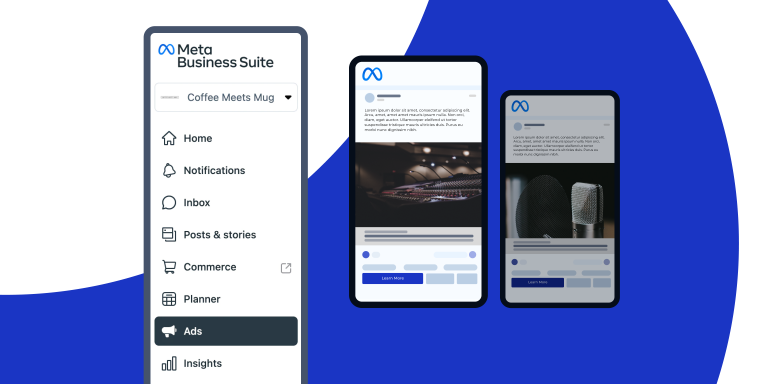The real secrets to Facebook success lie in the way we view the advertising platform. Far from being another surface-level guide claiming to have insider knowledge, we want to share a more actionable perspective based on strategies we’ve seen work for customers and our own programs.
Let’s dive in.
Facebook’s ad platform has always been an enigma, thanks to its ever-changing algorithm. Our goal is to help you achieve more meaningful results and help you better understand how Meta’s tools can help you as a marketer. Though the platform has vast targeting features, it’s still tough to reach the right audience. Add in the constant changes, and you have a recipe for only short-lived solutions. That’s enough to frustrate even the most experienced marketers.
In a world of OKRs, KPIs, MQLs, etc., it’s easy to get lost in the numbers game. Ad platforms’ rapid transformations have led to corner-cutting strategies focused on quick results. Advertisers of all backgrounds get tunnel vision, trying to squeeze as much as possible out of algorithms—as fast as they can. But ecommerce customers are evolving, and getting stuck in the rigid thinking of conventional wisdom can be dangerous.
Facebook was built for connection. We’re all accountable for budgets and success metrics, but we can’t lose sight of that fact. Connection still motivates members’ actions, and it has given direct-to-consumer (D2C) brands unprecedented influence over the past few years when they can truly build a connection between brand and customer. If you care about reaching your audience, prioritize learning what makes them tick. Success on Facebook can only come from crafting stories that create meaningful connections.
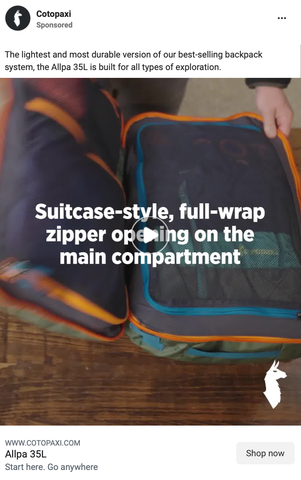
Cotopaxi’s Facebook ecommerce ad connects us to a sense of adventure, which is a priority to many of their customers.
The current state of Facebook Ads
Before we dive into the flaws of traditional strategies, remember how young this platform is. Google launched AdWords in 2001, and Facebook followed with their ad services five years later. The whole industry is less than 25 years old.
In this short time, advertising platforms such as these have become influential forces in most people’s daily routines. That level of influence has led to much greater precision.
Today, Google and Meta ads have completely taken control of the pre-click stage of the advertising funnel. If marketers want the best reach for the best price, there is no other option than to leverage the combination of powerful platforms.
Much of today’s marketing knowledge revolves around maximizing value on advertising platforms. Advertisers adjust to the unique preferences of each platform’s algorithm to optimize spend. That approach has led some advertisers to disproportionately focus on the algorithm.
Meta has several advantages that power its success
Meta may have peaked in 2021 with $114 billion in ad revenue, and the platform is still a major player. Meta maintains high conversion rates compared to other ad platforms—they get twice the conversions of Google PPC ads.
As a dominant social media platform, the company has had years to perfect its advertising ecosystem. They’ve built sophisticated data models based on vast caches of user behavior data. Meta lets advertisers leverage this data to create audiences for on-platform advertising campaigns.
Many brands today consider themselves Facebook success stories because their ads provide great exposure for SMBs. They can place their products into people’s feeds without the clutter of bigger brands distracting them. This fosters a personal link between customer and product in the pre-click stage. Over time, smart Facebook marketing strategies can lead companies to growth from small to medium to enterprise-level businesses.
The platform has disadvantages as well
- Younger users are leaving Facebook for platforms like TikTok and Instagram
- The company has a tarnished reputation after several data privacy scandals, like Cambridge Analytica in 2016. It’s suspected to have played a role in their name change
- Meta is notorious for changing its algorithm to favor different types of content. For example, Facebook’s “shift to video” in 2014 dramatically affected the journalism industry. That’s part of the reason advertisers are on constant alert to changes in the platform
- Advertisers need to closely review their targeting parameters, as the platform’s user data can have blind spots. For example, just because someone lists their profession as a “doctor,” they may not be the right audience for a campaign targeting pediatricians
These perceptions have some truth to them. Demographics on Facebook are always shifting, and Meta’s use of user data is still a hot topic of debate. But the benefits far outweigh the challenges. Meta remains an essential tool for advertisers who want to run personalized campaigns at scale.
Despite the constant changes to Meta’s platform, its market share of the D2C industry has maintained steady growth. With that growth came plenty of new functionalities and mediums for advertisers to take advantage of. Today, the complexity of Meta advertising has reached a peak that’s left marketers scrambling. But the one question at the top of all marketers’ minds:
“How can you get the best return on your Facebook ad spend?”
To answer that, we must first define some terms. How does Facebook advertising work, and what do advertisers need to know?
How Facebook advertising works
Facebook has over 2 billion active monthly users worldwide— a gargantuan audience that includes over 39.8% of the world’s population. Over the years, Meta has collected a deep well of user data from Facebook to present users with ads that match their interests and persona.
Meta’s advertising ecosystem relies on continuing to get user data. Not only do they prompt people to give personal info, but they also track their behavior off-platform.
Here are some examples of the data Meta collects:
On-platform data
- Interests and groups
- Friends and family
- Web habits and time spent on site
- Ad clicks
Off-platform data
- IP address
- Websites using the Meta Pixel
- Browsing history
- Search data
The platform monitors web behavior, so a visit to, say, Outside Magazine’s website might show an interest in fitness and the outdoors. Personal data such as this is invaluable to advertisers.
D2C marketing strategies and Facebook advertising closely align—they both focus on personalization. Meta knows that personalization converts, which is why their ad options include a slate of experiences. These tools give marketers everything they need to craft targeted campaigns.
Core Audiences let advertisers create lists based on demographic data. That includes age, interests, geographic location, and more. Use Core Audiences to target your most important buyer personas.
Lookalike Audiences target users with similar interests to your existing audiences. Lookalike Audiences help you grow your audience size while retaining your targeting parameters.
Custom Audiences allow you to build audiences based on your customer data. This option presents advertisers with ideas for creative personalization strategies.
Excluding Audiences makes your campaigns more precise by cutting out redundant or irrelevant targets from your list.
Each of these tools empower marketers’ personalized campaigns without much manual effort. Used in perfect balance, the suite of personalization features at the pre-click stage gives you major fire-power.
Sync Facebook with your CRM
So, how can advertisers fully incorporate these targeting tools to make their ads more effective? The key is to leverage your CRM. Here’s how it works.
- First, upload your existing contact list to Facebook as a Custom Audience for the segment that you want to target. Now, you can leverage Facebook’s audience-building tools for your contact list.
- From there, create Lookalike Audiences based on your existing list. Doing so is a powerful way to find high-value leads with qualities that match your target audience. You’re basically letting Facebook cross-analyze your current audience list and use its data to expand your list.
Audience targeting is a crucial part of any advertising campaign—but don’t get trapped in a pre-click mindset. Advanced targeting with so many factors opens the door to continued segmentation. That’s a lot of precision to take advantage of (or to squander). Be prepared to maximize the benefits of these tactics by stepping back and considering personalization as a whole.
Connecting your CRM to Facebook also means the leads you create with your targeted ads feed into your sales funnel for prompt follow-up. This way, you can develop nurture campaigns for new leads, which in turn helps you turn more of them into customers.
But external characteristics only enable surface-level targeting. If you want your campaigns to drive conversions, you need to understand how your audience thinks.
Psychographic personalization and audience segmentation
The true value of personalization is the ability to build the momentum of interest into a conversion. The question for marketers is, what story does each of your audiences need to hear to convert?
Here’s where psychographic segmentation comes into play. Psychographic segmentation is defined as segmentation that focuses on intrinsic characteristics:
- Interests
- Activities
- Opinions
- Values
- Income bracket
- Pain points
Advertisers can use these characteristics to predict how people will react to specific messaging. For example, a marketer could segment toward audience members who seek to be a part of a trend. Messaging that drives FOMO—like flashy LED lights for your gaming setup—would be effective with this psychographic type.
Psychographic segmentation helps you inject your products into consumers’ specific values, beliefs, and interests. Marketers who leverage this data report stronger customer relationships, purchase intent, and brand loyalty. They also benefit from over a 20% lift in sales, 40% or higher ROI, and 30% or higher marketing-spend efficiency.
How can you segment your audience by belief systems or psychological types?
The answer is to use Meta’s built-in targeting tools—like Custom Audiences and Lookalike Audiences—with a critical eye. Consider what’s most valuable to each of your audience segments. To do this right, you must employ empathy and sound judgment, since psychographic data derives from a person’s internal worldview. The careful consideration pays off when you can craft narratives that evoke genuine and memorable reactions from your audience.
This all culminates in the post-click stage of the experience—the landing page. Luckily, Meta’s mastery of the pre-click stage provides a lot of legwork for SMBs. Instead of burning resources in this stage of the journey, you can focus on high-impact efforts to outshine the old-guard brands.
The landing page experience connects people to your brand and entices customers to dive deeper into your offerings. On the flip side, failing to craft the compelling stories that fuel engaging advertising journeys is a disservice to the audience. Today’s audiences will notice the lack of connection—and bounce.
Conversion decisions don’t begin with the click. They happen much sooner, during the story. This is where the principle of conversion storytelling comes into play.
Conversion storytelling is crucial to Facebook success
Stories have power. Human beings use them to live vicariously through new perspectives and experiences. Stories help us imagine what might be. They make desires feel tangible. We use them to educate, to inspire, to caution, to advise, to bond, and, yes, to advertise.
Conversion storytelling is an end-to-end user experience that conveys the value of a product or service in a creative and human way. Think of a Hollywood blockbuster. It generally starts with a thrilling hook that gets you emotionally invested in a character, a goal, and a challenge to overcome. The story carries you through the tension of conquering obstacles to reach a cathartic conclusion. The goal of conversion storytelling is to use that principle in an advertising context.
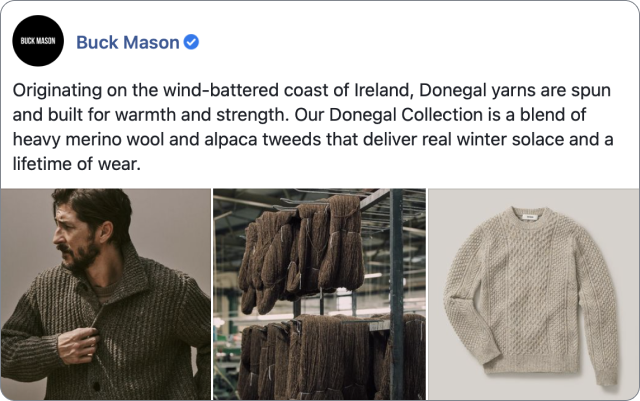
Buck Mason’s Facebook ad example starts telling a story about how their sweaters are made, which creates value.
What does this mean in the context of Facebook advertising?
Think of your Facebook ad as the movie preview for your story. Your title is the alluring sneak peek and your imagery tells visitors this is the story they want to discover. Once they click the ad, they’ve shown up at the theater and are ready to invest time into your story—in this case, your landing page.
Now, they expect to get drawn into the story. If you do your job, they will go through a journey until they reach the moment of truth—the conversion action—and then the happily ever after of their purchase.
When you fail to craft a landing page experience that moves your ad’s story forward, you will lose potential customers. It’s like showing up to a comedy and realizing all the good jokes were in the preview—disappointing.
Focus on these questions when planning the narratives for your Facebook ads.
-
- What product or service are you advertising? This answer defines the core of your ad narrative.
- Who is your story’s main character? If you think your ad’s story is all about the product, you’re missing the mark.
The character of the story is the audience. Your offer is the guide—Yoda, so to speak—whereas the landing page visitor is Luke.
- What is the brand voice? Your brand is more than a collection of aesthetic choices. Your brand plays a pivotal role in the story, and how you personify that role can dramatically impact your narrative.
- Who is the targeted persona? Your ad group should be specific and targeted to the audience you’ve invested in. Craft your narrative around your unique persona’s worldview and preferences.
- What problem are you trying to solve for the persona? Consider the point of tension in your story—the question your product or service can answer for the audience.
- How does your product/service solve the problem? Prove how your solution is better than the competition. Show that you understand what’s at stake. Even if the product is as simple as toilet cleaner, make the audience feel like you appreciate how valuable it is to have clean toilets.
- What emotional response are you trying to evoke? What emotions does your audience respond to? How does your product relate to that emotional response? What might they feel like if they don’t find a solution to their challenge? Your messaging needs to show that you understand these emotional reactions.
You may already consider these questions when developing your ad copy, but again, we’re looking at the entire customer journey. It’s crucial to apply the same principles after your audience has shown interest, all the way to your landing page—and thank you page.
Structuring your story after a click
Conversion storytelling is all about what happens after the user clicks an ad. Here’s how to continue your conversion storytelling narrative in your landing page experiences.
Hero headline
In one sentence, make a no-frills statement showing the tension, solution, and resolution.
Above the fold
Write a short story (two to four sentences) that answers the questions posed in the ad. Continue the story by summarizing the problem, solution, and resolution.
Long-form narrative flow
Now that your audience has journeyed from ad-to-page and stuck around long enough to check out your content, it’s time to conclude your story. To do that, you’ll need to answer these questions:
- Why is this the best solution to the problem? Can you provide any proof or supporting data?
- How does this product or service work, in detail? What makes it unique?
- Who else has used this product or service? What were their results?
By answering these questions, you’ve prepared yourself to create a landing page that builds a clear bridge from ad to conversion.
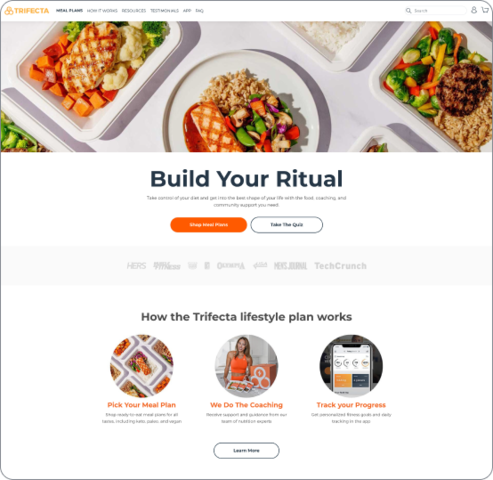
Trifecta’s landing page illustrates how all of these elements work together to tell a naturally cohesive story.
Create conversion-oriented landing page experiences
Each landing page design needs to be as sharp, compelling, and narrative-driven as your ads. Consider these three factors to drive more conversions.
Message match
As we’ve discussed, conversion storytelling means continuing the same message from the ad to the landing page. And message matching does more than support your narrative and improve conversions. Consistency earns you a higher Quality Ranking within Meta’s ad ecosystem, for better placement at lower costs.
Visual hierarchy
Your landing page is a story in itself. The top of the page acts as the hook that entices readers to continue scrolling down the page. You can use design elements like image or text size, spacing, contrast, and more to easily draw the eye where you want it to go. That way, you can reinforce your narrative and guide the reader toward the intended action.
Keep it brief
Communicate your narrative through concise, powerful copy. Audiences can get lost when confronted with a dense paragraph, so be sure to highlight the most relevant messages with punchy prose.
Use this strategy to craft a narrative and landing page experience for each of your ad groups.
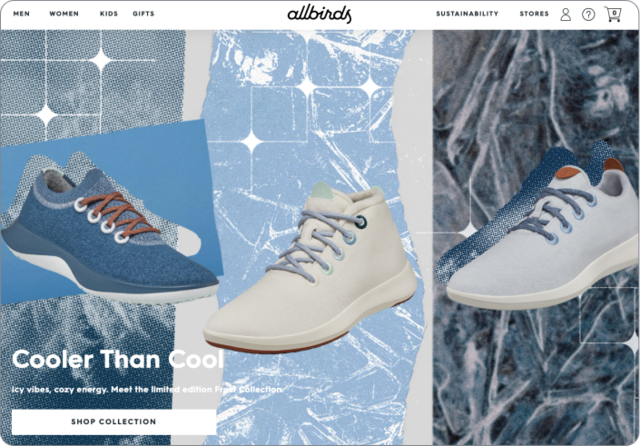
Allbirds’ landing page carries through the witty messaging visitors would have received in the original ad. A perfect D2C marketing example.
Ongoing experimentation sharpens your ad-to-page narratives
Once your ad-to-page narratives are ready for each audience segment, the real work begins. You need to fine-tune your campaigns with experimentation and A/B testing. It’s not enough to test a new page once or twice a quarter (or a year). You need to grab new customers, retain loyalty, and increase cart size every time. Ongoing experimentation is the only way to optimize your conversion rates for this vital level of consistent success.
Conversion rate optimization (CRO) can be a large undertaking, especially at scale. But the challenges don’t outweigh the benefits. CRO will elevate your advertising journey to new heights of success. Keep these key pieces in mind as you launch, test, and optimize those journeys.
Evaluate success
The first thing you want to do is evaluate your success. You’ve created highly personalized journeys for specific audiences, but are they engaging with your content? Are they settling on one product without expanding their interest in your catalog? What are your cart abandonment rates? The secret here is to know your audience. Perhaps you’ve misjudged the priorities and goals of your ad group. There are a few ways to measure disconnects:
- Heatmaps: Where on your page are your users spending the most time? Where are they spending the least time?
- Click stream data: What do your users find engaging? What is receiving lower levels of engagement?
- Bounce rates: Who is leaving your site—and when?
- Focus groups and user interviews: What do your customers have to say?
Successful experimentation requires customer data to inform your hypotheses. There are powerful tools available to help you better understand customer behavior. Be sure to leverage tools like Meta Pixel on your page to track where your traffic is coming from.
Experiment on your page
Once you’ve got an idea of what elements influence page behavior, you can now effectively experiment. The first step is to construct a hypothesis. Here’s what you need to define first:
- What is the user problem you’re trying to solve?
- What is the proposed solution?
- What are the anticipated results?
You need to hit a sweet spot of insights to get meaningful results. That requires consistent testing. And you have to make sure you’re building a large enough sample size over a long enough period of time to start finding actionable data. This process also requires resources and tools for A/B testing your pages. It’ll be harder to maintain consistent standards with testing like this at scale if you’re relying purely on internal teams. Tools like Instapage, designed for such purposes, help keep your data flow organized and easily digestible.
Consider testing crucial elements, like the user experience design, copy and creative, and so on. Over time, page performance will increase as visitors connect to these living, breathing landing pages.
Image
Navigating Facebook advertising is tricky, but the benefits are undeniable
So after all that, what secrets of successful Facebook strategies do you need to put in place for more conversions?
Treat your Facebook ads as one part of a larger advertising narrative. Facebook has mastered the pre-click stage, so you should focus on the area where you control the impact—creativity in the post-click stage.
Understanding these secrets of Facebook advertising is crucial to improve your return on ad spend. But not every company has the resources to implement this strategy at scale. Building and scaling multiple landing pages is a time-consuming and costly effort that many companies consider out of reach. When you factor in multiple pages, that effort only multiplies.
Instapage makes personalization attainable. We keep our fingers on the pulse of the latest industry trends and lead the way with our robust landing page platform and our deep CRO knowledge. We are experts in helping marketers optimize strategies and campaigns. No matter the platform, the industry, or the conversion goal, we can work with you to increase your results.
Book a demo today to find out how.
